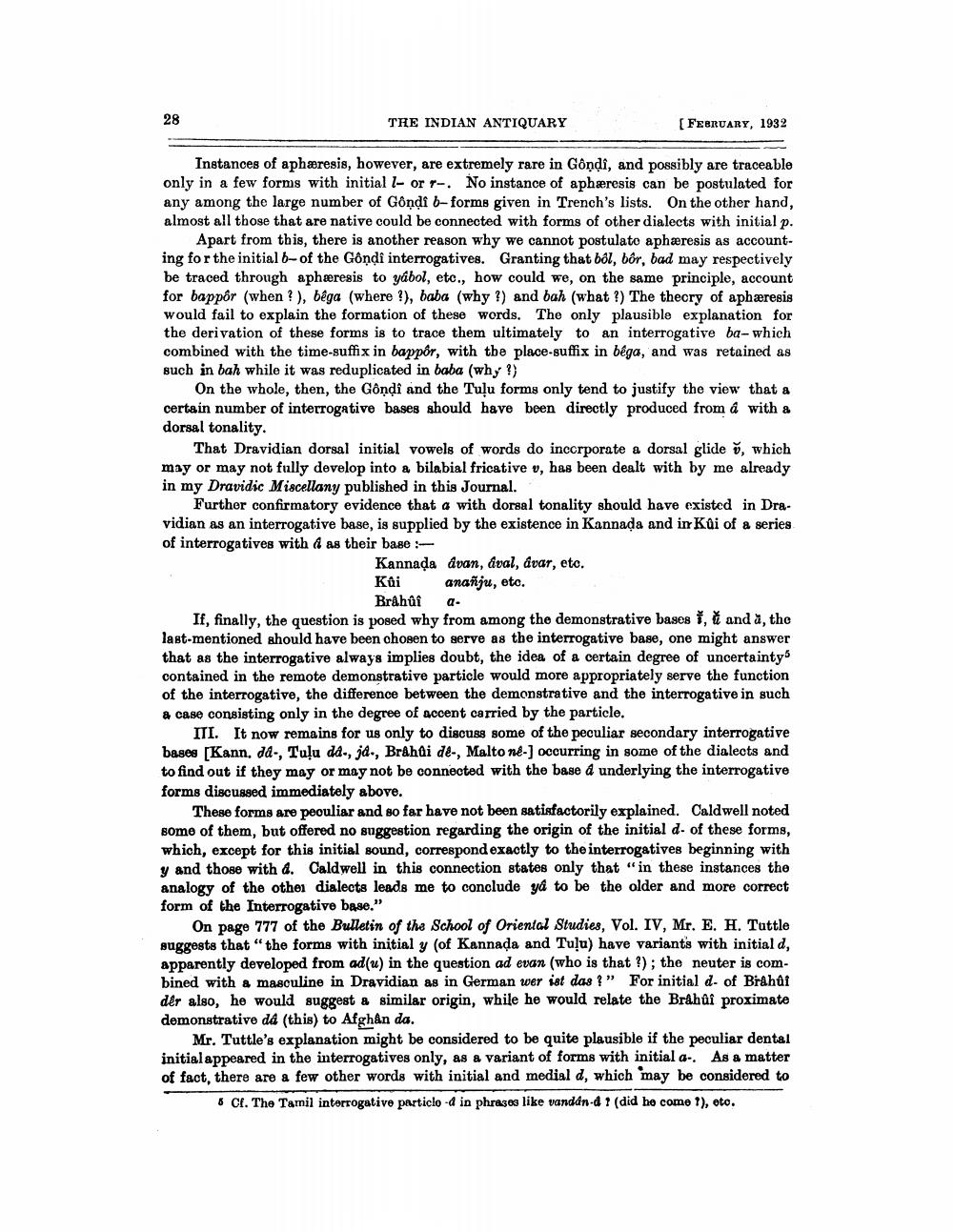________________
THE INDIAN ANTIQUARY
(FEBRUARY, 1932
Instances of aphæresis, however, are extremely rare in Gôndi, and possibly are traceable only in a few forms with initial l-orr-. No instance of aphæresis can be postulated for any among the large number of Gôndi b-forms given in Trench's lists. On the other hand, almost all those that are native could be connected with forms of other dialects with initial p.
Apart from this, there is another reason why we cannot postulato aphæresis as accounting for the initial b-of the Gôndi interrogatives. Granting that bál, bôr, bad may respectively be traced through aphæresis to yábol, etc., how could we, on the same principle, account for bappor (when ?), bêga (where ?), baba (why ?) and bah (what?) The theory of aphæresis would fail to explain the formation of these words. The only plausible explanation for the derivation of these forms is to trace them ultimately to an interrogative ba- which combined with the time-suffix in bappôr, with the place-suffix in béga, and was retained as such in bah while it was reduplicated in baba (why?)
On the whole, then, the Gôndi and the Tulu forms only tend to justify the view that a certain number of interrogative bases should have been directly produced from a with a dorsal tonality.
That Dravidian dorsal initial vowels of words do incorporate a dorsal glide õ, which may or may not fully develop into a bilabial fricative v, has been dealt with by me already in my Dravidic Miscellany published in this Journal.
Further confirmatory evidence that a with dorsal tonality should have existed in Dravidian as an interrogative base, is supplied by the existence in Kannada and in Kui of a series of interrogatives with d as their base :
Kannada dvan, aval, avar, eto. Kai ananju, eto.
Brahûfa. If, finally, the question is posed why from among the demonstrative bases 1, è anda, the last-mentioned should have been chosen to serve as the interrogative base, one might answer that as the interrogative always implies doubt, the idea of a certain degree of uncertaintys contained in the remote demonstrative particle would more appropriately serve the function of the interrogative, the difference between the demonstrative and the interrogative in such & case consisting only in the degree of accent carried by the particle.
III. It now remains for us only to discuss some of the peculiar secondary interrogative bases [Kann, da-, Tuļu da., d., Brahui de-, Malto né.] occurring in some of the dialects and to find out if they may or may not be connected with the base à underlying the interrogative forms discussed immediately above.
These forms are peouliar and so far have not been satisfactorily explained. Caldwell noted some of them, but offered no suggestion regarding the origin of the initial d- of these forms, which, except for this initial sound, correspond exactly to the interrogatives beginning with v and those with 4. Caldwell in this connection states only that "in these instances the analogy of the other dialects leads me to conclude yå to be the older and more correct form of the Interrogative base."
On page 777 of the Bulletin of the School of Oriental Studies, Vol. IV, Mr. E. H. Tuttle suggests that "the forms with initial y of Kannada and Tulu) have variants with initial d, apparently developed from ad(u) in the question ad evan (who is that?); the neuter is combined with a masculine in Dravidian as in German wer ist das?" For initial d. of Brahaf der also, he would suggest a similar origin, while he would relate the Brahui proximate demonstrative dd (this) to Afghán da.
Mr. Tuttle's explanation might be considered to be quite plausible if the peculiar dental initial appeared in the interrogatives only, as a variant of forms with initial a.. As a matter of fact, there are a few other words with initial and medial d, which may be considered to
6 Cl. The Tamil interrogative particlo-d in phrases like vandan-d + (did he come 1), eto.




